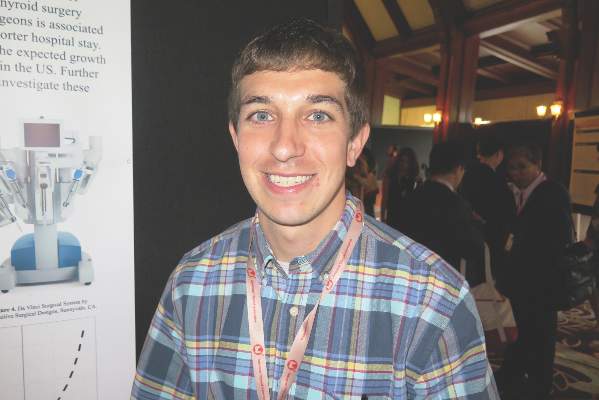User login
CORONADO, CALIF. – Robotic thyroid surgery performed at the highest-volume center had a lower complication rate and shorter hospital stays than did the other hospitals in the study, results from a study of national data showed.
The Food and Drug Administration suspended its approval of robotic thyroidectomy in October 2011, citing risks and lack of adequate safety and outcomes research. The researchers observed a drop in the number of robotic thyroidectomies performed in the United States after the FDA issued its restriction in 2011. “That move appears to have made a pretty large impact on the projected growth of this procedure,” Dr. Hinson said at the annual meeting of the American Thyroid Association.
In Korea, where the procedure gained recognition in the early 2000s, “a lot of people cite cultural factors, such as aversion to neck scars, lean body habitus, and low body mass index make the procedure more feasible, so it’s a very popular approach there,” said Dr. Hinson, a research fellow at the University of Arkansas for Medical Sciences, Little Rock. In addition, until recently, there were financial incentives to do thyroid surgery with robotic assistance in the Korean health care system. “That said, in the United States, the cultural forces are distinct, our patients are larger and heavier on average, and most patients don’t have a strong aversion to a neck scar. The procedure is paid the same with or without the robot, but takes on average three times as long with the robot. Surgeons have such great results with open techniques that it’s very hard to make an argument that robotic surgery improves outcomes that much.”
In what is believed to be the largest study of its kind in the United States, Dr. Hinson and his associates evaluated data from the University HealthSystem Consortium (UHC) and an additional academic center which did not participate in the UHC discharge database. The study included 484 patients who underwent robotic thyroidectomy in the United States between 2009 and 2013. Data were compiled from discharge summaries at 110 university medical centers and another 140 of their affiliated hospitals. The researchers collected data on age, gender, race, insurance, comorbidities, complications, discharge status, length of stay, and ICU admission.
Dr. Hinson and his associates found that, compared with outpatients, inpatients had significantly greater numbers of comorbidities and complications. The most common comorbidity was hypertension (12 cases), followed by chronic pulmonary disease (8 cases) and diabetes with complications and comorbidities (6 cases). The median hospital length of stay was 1 day for inpatients, and 57% of outpatients stayed overnight. In addition, 8% of inpatients required an ICU stay, while 99% of outpatients and 97% of inpatients were discharged to home. The highest-volume institution in the data set performed most of the outpatient cases and had a lower rate of complications. “That makes sense,” Dr. Hinson said. “If you’re proficient, you’re more likely to have learned how to avoid complications.
“The approach to the neck has largely been unchanged over the last 100 years,” he said. While several other surgical fields have found highly successful and popular niches for endoscopic and/or robotic technology, the uses for these services has been largely limited in head and neck surgery. The da Vinci system was largely created with abdominal surgery in mind. As surgical techniques and robotic technology develop, systemic applications for this technology, previously unrecognized, may emerge. A lot of academic centers were/are hopeful that robotic thyroid surgery may provide the gateway for advancement of such techniques in the head and neck region.”
He reported having no financial disclosures.
On Twitter @dougbrunk
CORONADO, CALIF. – Robotic thyroid surgery performed at the highest-volume center had a lower complication rate and shorter hospital stays than did the other hospitals in the study, results from a study of national data showed.
The Food and Drug Administration suspended its approval of robotic thyroidectomy in October 2011, citing risks and lack of adequate safety and outcomes research. The researchers observed a drop in the number of robotic thyroidectomies performed in the United States after the FDA issued its restriction in 2011. “That move appears to have made a pretty large impact on the projected growth of this procedure,” Dr. Hinson said at the annual meeting of the American Thyroid Association.
In Korea, where the procedure gained recognition in the early 2000s, “a lot of people cite cultural factors, such as aversion to neck scars, lean body habitus, and low body mass index make the procedure more feasible, so it’s a very popular approach there,” said Dr. Hinson, a research fellow at the University of Arkansas for Medical Sciences, Little Rock. In addition, until recently, there were financial incentives to do thyroid surgery with robotic assistance in the Korean health care system. “That said, in the United States, the cultural forces are distinct, our patients are larger and heavier on average, and most patients don’t have a strong aversion to a neck scar. The procedure is paid the same with or without the robot, but takes on average three times as long with the robot. Surgeons have such great results with open techniques that it’s very hard to make an argument that robotic surgery improves outcomes that much.”
In what is believed to be the largest study of its kind in the United States, Dr. Hinson and his associates evaluated data from the University HealthSystem Consortium (UHC) and an additional academic center which did not participate in the UHC discharge database. The study included 484 patients who underwent robotic thyroidectomy in the United States between 2009 and 2013. Data were compiled from discharge summaries at 110 university medical centers and another 140 of their affiliated hospitals. The researchers collected data on age, gender, race, insurance, comorbidities, complications, discharge status, length of stay, and ICU admission.
Dr. Hinson and his associates found that, compared with outpatients, inpatients had significantly greater numbers of comorbidities and complications. The most common comorbidity was hypertension (12 cases), followed by chronic pulmonary disease (8 cases) and diabetes with complications and comorbidities (6 cases). The median hospital length of stay was 1 day for inpatients, and 57% of outpatients stayed overnight. In addition, 8% of inpatients required an ICU stay, while 99% of outpatients and 97% of inpatients were discharged to home. The highest-volume institution in the data set performed most of the outpatient cases and had a lower rate of complications. “That makes sense,” Dr. Hinson said. “If you’re proficient, you’re more likely to have learned how to avoid complications.
“The approach to the neck has largely been unchanged over the last 100 years,” he said. While several other surgical fields have found highly successful and popular niches for endoscopic and/or robotic technology, the uses for these services has been largely limited in head and neck surgery. The da Vinci system was largely created with abdominal surgery in mind. As surgical techniques and robotic technology develop, systemic applications for this technology, previously unrecognized, may emerge. A lot of academic centers were/are hopeful that robotic thyroid surgery may provide the gateway for advancement of such techniques in the head and neck region.”
He reported having no financial disclosures.
On Twitter @dougbrunk
CORONADO, CALIF. – Robotic thyroid surgery performed at the highest-volume center had a lower complication rate and shorter hospital stays than did the other hospitals in the study, results from a study of national data showed.
The Food and Drug Administration suspended its approval of robotic thyroidectomy in October 2011, citing risks and lack of adequate safety and outcomes research. The researchers observed a drop in the number of robotic thyroidectomies performed in the United States after the FDA issued its restriction in 2011. “That move appears to have made a pretty large impact on the projected growth of this procedure,” Dr. Hinson said at the annual meeting of the American Thyroid Association.
In Korea, where the procedure gained recognition in the early 2000s, “a lot of people cite cultural factors, such as aversion to neck scars, lean body habitus, and low body mass index make the procedure more feasible, so it’s a very popular approach there,” said Dr. Hinson, a research fellow at the University of Arkansas for Medical Sciences, Little Rock. In addition, until recently, there were financial incentives to do thyroid surgery with robotic assistance in the Korean health care system. “That said, in the United States, the cultural forces are distinct, our patients are larger and heavier on average, and most patients don’t have a strong aversion to a neck scar. The procedure is paid the same with or without the robot, but takes on average three times as long with the robot. Surgeons have such great results with open techniques that it’s very hard to make an argument that robotic surgery improves outcomes that much.”
In what is believed to be the largest study of its kind in the United States, Dr. Hinson and his associates evaluated data from the University HealthSystem Consortium (UHC) and an additional academic center which did not participate in the UHC discharge database. The study included 484 patients who underwent robotic thyroidectomy in the United States between 2009 and 2013. Data were compiled from discharge summaries at 110 university medical centers and another 140 of their affiliated hospitals. The researchers collected data on age, gender, race, insurance, comorbidities, complications, discharge status, length of stay, and ICU admission.
Dr. Hinson and his associates found that, compared with outpatients, inpatients had significantly greater numbers of comorbidities and complications. The most common comorbidity was hypertension (12 cases), followed by chronic pulmonary disease (8 cases) and diabetes with complications and comorbidities (6 cases). The median hospital length of stay was 1 day for inpatients, and 57% of outpatients stayed overnight. In addition, 8% of inpatients required an ICU stay, while 99% of outpatients and 97% of inpatients were discharged to home. The highest-volume institution in the data set performed most of the outpatient cases and had a lower rate of complications. “That makes sense,” Dr. Hinson said. “If you’re proficient, you’re more likely to have learned how to avoid complications.
“The approach to the neck has largely been unchanged over the last 100 years,” he said. While several other surgical fields have found highly successful and popular niches for endoscopic and/or robotic technology, the uses for these services has been largely limited in head and neck surgery. The da Vinci system was largely created with abdominal surgery in mind. As surgical techniques and robotic technology develop, systemic applications for this technology, previously unrecognized, may emerge. A lot of academic centers were/are hopeful that robotic thyroid surgery may provide the gateway for advancement of such techniques in the head and neck region.”
He reported having no financial disclosures.
On Twitter @dougbrunk
AT THE ATA ANNUAL MEETING
Key clinical point: Robotic thyroid surgery performed by higher-volume surgeons is associated with lower complications and shorter hospital stays.
Major finding: Compared with outpatients, inpatients had a significantly greater number of comorbidities (P < .001) and complications (P =.005). In addition, the highest-volume institution in the data set performed most of the outpatient cases and had a lower rate of complications.
Data source: A study of 484 patients from the University HealthSystem Consortium who underwent robotic thyroidectomy in the United States between 2009 and 2013.
Disclosures:Dr. Hinson reported having no financial disclosures.

